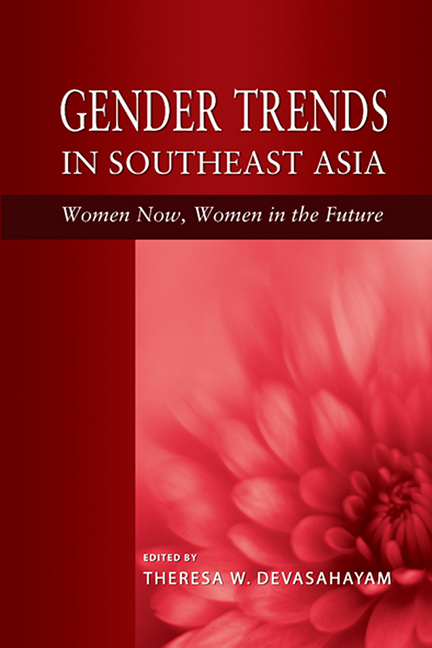Book contents
- Frontmatter
- Contents
- Contributors
- List of Tables and Figures
- Foreword
- Message
- Acknowledgements
- 1 Introduction: Women in Southeast Asia: Changes and Continuities
- 2 Women, Marriage and Family in Southeast Asia
- 3 Gender Trends in Migration and Employment in Southeast Asia
- 4 Has Gender Analysis been Mainstreamed in the Study of Southeast Asian Politics?
- 5 Gender Mainstreaming in Health: Mainstream or “Off-Stream”?
- 6 Politicization of Islam in Indonesia and Malaysia: Women's Rights and Inter-Religious Relations
- Index
Foreword
Published online by Cambridge University Press: 21 October 2015
- Frontmatter
- Contents
- Contributors
- List of Tables and Figures
- Foreword
- Message
- Acknowledgements
- 1 Introduction: Women in Southeast Asia: Changes and Continuities
- 2 Women, Marriage and Family in Southeast Asia
- 3 Gender Trends in Migration and Employment in Southeast Asia
- 4 Has Gender Analysis been Mainstreamed in the Study of Southeast Asian Politics?
- 5 Gender Mainstreaming in Health: Mainstream or “Off-Stream”?
- 6 Politicization of Islam in Indonesia and Malaysia: Women's Rights and Inter-Religious Relations
- Index
Summary
“Gender Trends in Southeast Asia: Women Now, Women in the Future” was a symposium held on 4 December 2008 in conjunction with the Gender Studies Programme of the Institute of Southeast Asian Studies. Established in 2005, the Programme seeks to explore how gender inequality plays out in the Southeast Asian region. More specifically, the Programme examines two broad areas: (a) wo(men) and politics, and (b) the health and social concerns of vulnerable women including sex workers, trafficked women, internally displaced women, low-skilled migrant women workers, and poor women independently heading households. The objective of the Programme is to emphasize two points: (a) that gender is a field worthy of rigorous study because a gender perspective is critical to give voice to women, and (b) that ISEAS undertakes research in several emerging concerns related to women in the region.
Why the focus on women's issues is a justifiable question. Since women make up half of the world's population, research and analysis on women is critical in understanding one of many forms of social stratification. Undoubtedly women face unique disadvantages and, in turn, social problems because of their gender identity. Hence in some contexts, it becomes important to formulate policies informed by critical debate to ensure that women are not left behind and that they share in the fruits of development equally with men. For these reasons and many others, the trends and changes in women's lives and the obstacles women face in advancement and securing their own rights are worthy of research, documentation and analysis.
The recent symposium provided a platform for discussion of various issues related to women in contemporary Southeast Asia. Since the symposium was the first in the series on “Gender Trends in Southeast Asia”, the speakers' presentations covered a broad range of topics: (a) women and family; (b) women and employment; (c) women and politics; (d) women and health; and (e) women and religion.
- Type
- Chapter
- Information
- Gender Trends in Southeast AsiaWomen Now, Women in the Future, pp. xi - xiiPublisher: ISEAS–Yusof Ishak InstitutePrint publication year: 2009

